bleaching
bleaching
Always whiten your teeth under the supervision of your dentist or dental hygienist
White and radiant teeth. Who doesn't want that? Beautiful white teeth are popular and the offer to get them is large. The commercials promise snow-white teeth, often even within an hour. Whitening teeth with the help of bleaching treatments is possible in many cases, but certainly not always. Unsafe bleaching processes can damage your mouth. Since 2011, European legislation prohibits harsh bleaches containing more than 6% hydrogen peroxide. Are you considering a whitening treatment? Discuss your wishes and the options with your dentist or dental hygienist.
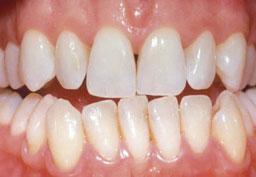
Result after ten days of bleaching with the home bleaching method under the supervision of the dentist
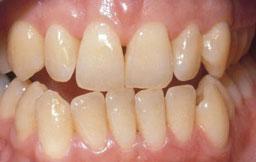
before bleaching
The color of your teeth
The color of teeth and molars is different for everyone. One has whiter teeth than the other. Some have yellow, others brown or gray teeth. Even in one mouth, teeth do not all have the same color and sometimes differ clearly from each other.
Teeth and molars are made up of dentine and enamel. The color and the thickness of the dentine mainly determine the color. The enamel of teeth and molars is almost transparent, but gives a white glow to the teeth. Canines have a thicker layer of dentin than the other teeth and are therefore often more yellow. Your teeth get darker as you get older. The formation of dentin always continues. The glaze layer actually becomes thinner due to wear.
In exceptional cases, diseases or medications can cause discoloration during the formation phase.
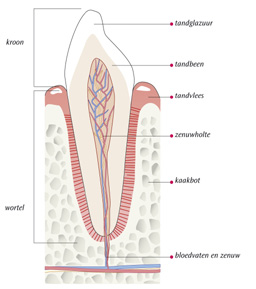
Tooth cross section
What causes teeth to discolor?
If dyes from foodstuffs and stimulants enter the tooth, the teeth look darker. This happens, among other things, by smoking and by eating and drinking coffee, tea, wine, soft drinks, fruit juice, or other food containing dyes. With age, cracks can appear in the enamel. As a result, dyes from food and drinks penetrate even more easily into the tooth. The old-fashioned almagam filling can also cause discolorations.
Tartar deposits and discoloration can also darken the teeth. These discolorations are also caused by coffee, tea, wine and smoking. Furthermore, strangely enough, some oral care products containing tin and chlorhexidine can cause discolorations. Ask your dental care professional. Deposits can be removed by a dentist or dental hygienist with a professional dental cleaning. Bleaching is not the solution for this.
Dead teeth (usually due to a fall or blow) can discolor from the inside. This can also happen after a root canal treatment.
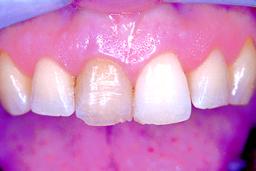
Discoloration from a dead tooth
White teeth, also for me?
Let the dentist or dental hygienist first assess your teeth. He must determine that your teeth are healthy and free of cavities and that your fillings are in order. Then he looks at the color of your teeth. Is there any discoloration? What is the cause? Do you have many fillings, crowns or bridges in your mouth? Is tarnish the cause of the discoloration? Is the result you envision realistic? Bleaching is not always the only or best solution. Fillings, crowns and bridges do not color along and can become disturbingly visible after bleaching. Your dental care provider will advise whether whitening is useful for you and what the result will be.
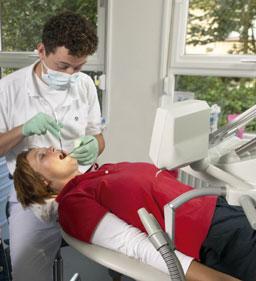
Have your teeth checked by your dentist or dental hygienist before you decide to whiten your teeth
Bleaching methods
Whitening from the outside in healthy teeth
Whitening at home under the supervision of the dentist or dental hygienist
If the discoloration is deposited, bleaching as described above is not the solution. Ask your dental care professional to clean your teeth. If there is discoloration in the tooth surface or if you think the color of the tooth is too dark, you can whiten from the outside. This is done with the help of a whitening spoon. First, the dentist or dental hygienist makes an impression of your teeth. With this, the dental technician in the dental laboratory makes a whitening tray of a soft transparent plastic that fits exactly over your teeth and leaves room for the whitening gel. A well-fitting whitening tray is important to prevent irritation of the gums. The whitening tray is the mold with which you apply the whitening gel to the teeth. The gel contains 3 to a maximum of 6% hydrogen peroxide. After a good instruction on how to apply the gel and when to carry the whitening tray, you will receive the whitening tray and a few squirts of whitening gel to take home. That is why this method is also called 'home whitening'. The dentist will indicate how long you should wear the whitening tray with the gel (usually at night) for the desired result. Depending on the discoloration, you will see an effect after a few days or weeks. Ultimately, the treatment takes two to three weeks. During bleaching, your teeth and gums may become temporarily sensitive. Consult your dentist or dental hygienist if this complaint occurs and ask for adapted instructions.
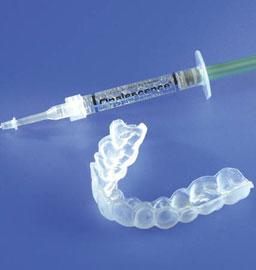
From the dentist or dental hygienist you will receive the transparent whitening tray and the gel with the whitening effect to take home
Whitening from the inside for 'dead' teeth
First, the dentist makes an opening at the back of the tooth. In this he applies a paste or gel with the bleaching agent. These products have a bleaching effect for a few days. Depending on the result achieved, the dentist repeats the treatment one or more times. Finally, he closes the tooth with a final filling.
Accelerated whitening treatments
Some dental practices and whitening shops offer accelerated whitening. Sometimes they use a lamp to heat the gel to speed up the process. It is not clear whether this actually gives a better result. Because in practice no stronger bleaching agents may be used than for home bleaching, it is impossible to achieve the same result in one go as with the home bleaching method. Experiments are also being carried out with alternative bleaching materials. Research on the results with these new materials is not yet available.
Questions and answers about whitening
What happens to your teeth when you whiten them?
Bleaching usually uses hydrogen peroxide. The peroxide breaks down dyes. In addition, the bleach temporarily dries out the teeth and makes them slightly more porous. This temporarily makes the enamel less transparent and you see the dark dentine less. The tooth color always darkens slightly after the bleaching treatment is finished. After six weeks you can only see the real whitening result.
How long does a whitening treatment take?
The length of a bleaching treatment depends on the bleaching method. With the home whitening method, it usually takes two to three weeks to achieve the desired result.
Can you whiten all teeth?
During a bleaching treatment, fillings, veneers (a shield of porcelain or composite), crowns and bridges do not color along. A whitening treatment for those teeth or molars is therefore pointless. They can even stand out more after whitening because of the whiter teeth and molars around them. Therefore, consult your dentist or dental hygienist before whitening your teeth. Discuss your wishes and ask whether your desired result is feasible.
Is home whitening under the supervision of a dentist or dental hygienist harmful to my teeth?
Research has shown that the outer part of the enamel is temporarily slightly more porous and less hard immediately after bleaching. These changes in the enamel recover as soon as the enamel comes into contact with saliva. Home whitening under the supervision of the dentist or dental hygienist, if you follow the instructions, has no lasting adverse consequences and delivers a better result than one-off treatments.
Can I eat and drink anything during the whitening treatment?
During treatment with the whitening tray, food and beverages containing dyes can adversely affect the result. During the bleaching treatment, the use of these products, as well as smoking, is not recommended. This will improve the durability of the bleaching result.
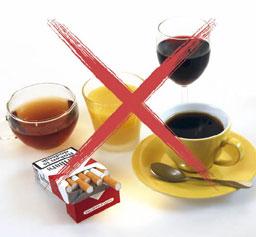
The use of these products is not recommended during treatment with the whitening tray
Can I whiten my teeth myself?
You can buy various bleaching products in some shops and especially via the internet. The law only allows very low concentrations of hydrogen peroxide (0.1%) for these products. This means that you can expect little effect from the treatment. Those who opt for this must also do without expert advice on whether a treatment is the right solution for you. If you want to whiten your teeth, always do so under the supervision of the dentist or dental hygienist.
What result will bleaching produce?
The whitening result to be achieved differs for everyone. Your dentist or dental hygienist can record the color of your teeth and show you what change has occurred. You can repeat the treatment if desired.
The basic color of the dentin largely determines the final result. And that base color is different for everyone. Whitened teeth, just like non-bleached teeth, will eventually discolour due to aging. Discoloration happens faster if you smoke or consume a lot of food with dyes.
Can I whiten my teeth with whitening toothpastes?
The name is somewhat misleading. Whitening toothpastes do not whiten. It contains enzymes and phosphates that can break down dyes and loosen them from the tooth, making them easier to brush away. Whitening toothpastes make it easier to remove discolorations on the surface. And clean teeth appear whiter. A new development is the addition of dyes to the toothpaste, which temporarily color the tooth white.